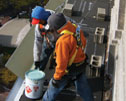With the arrival of spring, you probably are anxiously anticipating a substantial increase in business during the coming months that could act as a much-needed economic springboard for the remainder of 2010 and beyond. However, you also should anticipate increased Occupational Safety and Health Administration (OSHA) activity.
The diminished construction activity that has marked the recent past has not dampened OSHA's resolve to set a robust regulatory agenda and step up its compliance and enforcement efforts. Even limited success by OSHA to transform the regulatory landscape or increase enforcement will demand greater vigilance by roofing contractors regarding training efforts and revised work practices.
In a January speech to the Small Business Administration, OSHA's new assistant secretary of labor, David Michaels, stated the agency is focused on re-energizing several proposed OSHA standards that have been "stuck in the pipeline" for some time—the most conspicuous being its cranes standard.
Cranes
Subpart N of OSHA's Safety and Health Regulations for Construction, 29 CFR 1926.550-555, "Cranes, Derricks, Hoists, Elevators, and Conveyors," first was published in 1971. It was revised slightly in 1988 and 1993, and in July 2002, OSHA issued a notice of intent to establish a negotiated rulemaking committee for the purpose of developing a new cranes standard. The committee first met in July 2003, and a proposed rule was published in October 2008 with a final hearing on the rule held in March 2009.
Attempting to determine a date on which a cranes standard may be finalized is difficult; OSHA has stated its target month is July. Regardless of the exact date, you should be knowledgeable of the major provisions in the proposed version of the cranes standard to gain a sense of the procedures and practices OSHA may alter or institute in the future.
One issue of major importance is OSHA's proposed cranes standard contains certification provisions for crane operators and riggers. Some roofing contractors may be prepared regarding this issue because local licensing requirements for crane operators usually are based on training certifications that test the operator's control proficiency and knowledge of operational rules; local licensing requirements may be similar to those established in OSHA's proposed cranes standard.
According to the National Commission for the Certification of Crane Operators, about 25 states or municipalities have licensing and/or certification laws in place. OSHA's proposed cranes standard would require crane operators to be certified by an accredited crane operator testing organization; by an audited employer-provided qualification program; through qualification by military training; or through an eligible state licensing program.
Operators of equipment with a lifting capacity of 2,000 pounds or less would not need to meet the proposed standard's qualification or certification requirements. Workers who rig loads and maintenance and repair workers would need to meet specific qualifications according to the proposed standard.
After publishing the proposed cranes standard, OSHA was criticized—most notably by the American Society of Safety Engineers—for failing to reference any national voluntary consensus standards, such as the American National Standards Institute's A10 "Construction and Demolition Operations," when developing the standard. Therefore, it is possible OSHA's publication of a final rule will not be the last chapter in developing a new cranes standard.
Silica
Workplace hazards related to crystalline silica (the chemical compound silicon dioxide, commonly referred to as quartz) have drawn increased attention from OSHA during the past few years. OSHA's regulatory agenda seeks to develop a comprehensive health standard relating to worker exposure to inhalable crystalline silica, which can result in silicosis.
Silicosis is an irreversible but preventable lung disease caused by inhalation of respirable crystalline silica and the accumulation of those particles in the lungs.
In general, materials containing sand may release breathable particles of silica when cut, abraded or ground. Typical exposures in the construction industry include sandblasting; dry cutting brick, concrete, stone or clay tiles; rock drilling; and plastering. OSHA estimates that more than 2 million workers are exposed to crystalline silica each year, and levels of exposure often exceed OSHA's permissible exposure limit (PEL) for silica. Additionally, OSHA estimates between 3,500 and 7,000 new cases of silicosis arise each year in the U.S.
According to the National Institute for Occupational Safety and Health, there are three types of silicosis categorized by exposure time frames and airborne concentrations:
- Chronic silicosis from exposure to low concentrations of silica during a period of 10 years or more
- Accelerated silicosis that develops five to 10 years after initial exposure
- Acute silicosis that may develop within weeks of exposures to high concentrations of silica
OSHA warns that in the short term, silicosis can cause shortness of breath, fatigue and respiratory failure and may lead to development of bronchitis, tuberculosis, chronic obstructive pulmonary disease and lung cancer.
Currently, OSHA rules relating to crystalline silica in construction are found in 29 CFR 1926.55 under the general heading "Gases, vapors, fumes, dusts and mists." According to OSHA, the silica PEL from that section is based on a particle counting method (millions of particles per cubic foot of air) that is obsolete, resulting in the need to convert current sampling values to determine exposure under the section.
A new proposed standard is expected to address silica through a protocol similar to OSHA's asbestos or lead standards that set out specific methods of compliance, air-monitoring of worker exposures, worker training requirements and medical evaluations. Although not specifically referenced in OSHA's current silica standard, popular control methods to reduce or eliminate worker exposure to crystalline silica include wet-cutting materials and respiratory protection for workers.
Hazard communication
Another prominent issue on OSHA's regulatory agenda is revising certain elements of its hazard communication standard. Specifically, OSHA announced a proposed rule in September 2009 that attempts to conform its hazard communication standard to the United Nation's Globally Harmonized System (GHS) of Classification and Labeling of Chemicals. Hearings regarding the rule continue through this month, and OSHA has proposed employers achieve compliance within two years after the final rule's publication. For roofing contractors, the rule's key changes would be to material safety data sheets (MSDSs) and worker training requirements resulting from those revisions.
GHS is a worldwide initiative; its goal is to better protect human health and the environment through use of enhanced and consistent information about chemical hazards. According to the Environmental Protection Agency, GHS uses clear language and pictograms—simple drawings illustrating chemical hazards—conspicuously placed on product labels to alert users of chemical hazards.
According to GHS, product labels would include the chemical identity of a substance or a mixture's ingredients, as well as a hazard statement, such as "Harmful if swallowed." Conforming to GHS would require MSDSs to follow a specific format to ensure all necessary information about hazardous products is available to users.
Current OSHA requirements for information included in MSDSs are not as comprehensive as GHS requirements. Specifically, sections regarding disposal considerations, transport and ecological information, and regulatory details not presently required under OSHA's hazard communication standard would be required.
You can anticipate receiving revised MSDSs from manufacturers; some manufacturers already may have revised their MSDSs to comply. It will take a fair amount of administrative effort to ensure all MSDSs comply with GHS requirements once the rule becomes effective; train workers in the MSDS provisions for all the products they use; and make certain compliant MSDS forms are readily accessible to workers at job sites.
OSHA's new hazard communication standard also would change the term "material safety data sheet" to "safety data sheet."
Management systems
Safety and health management systems—comprehensive written safety programs—have been on OSHA's radar for some time. Current OSHA regulations do not specifically require such programs or set out components and elements to be included in such programs. Michaels has stated he is unsure of the best approach to implement this concept—through regulations, congressional action or other means.
California administers its own occupational safety and health plan and requires all employers in the state to adhere to a written injury and illness prevention program (IIPP). The structure of California's IIPP may be instructive for OSHA and employers in assessing the optimum components for a comprehensive safety program.
California's IIPP makes the following components mandatory:
- Management commitment and assignment of responsibilities
- A system for safety communications with employees
- A system for ensuring employee compliance with safe work practices
- A system of scheduled inspections and evaluations
- Procedures for correcting unsafe or unhealthy conditions
- Accident investigations
- Safety and health training and instruction
- Record keeping and documentation
OSHA efforts to adopt a standard relating to comprehensive safety programs likely would demand consideration of ANSI/AIHA Z10-2005, "American National Standard for Occupational Health and Safety Management Systems," as an alternative to pursuing a new standard through a notice of proposed rulemaking. Many of the standard's elements correspond to those required by California's IIPP. However, Z10-2005 provides more structure for the user in developing key components of a program as well as "annexes" containing explanations and forms to further assist with the program's practical implementation.
Through a grant from OSHA, NRCA also has created an educational session to assist roofing contractors with developing company safety programs focusing on a risk-management approach to safety. The free daylong session will be offered to roofing contractors throughout the U.S. through May 21.
Steps to comply
It is clear OSHA has no plans to shy away from its regulatory duties in the near future; rather, enforcement of OSHA regulations and the marshalling of agency assets to develop new regulations will mark the landscape for some time to come.
OSHA also is contemplating changes to some residential fall-protection rules as well as renewing efforts with regard to workplace ergonomics, so you need to make sure you stay current with OSHA activity, maintain compliance, and prepare to implement training and managerial controls by the effective dates to keep your company a step ahead of your local compliance officer.
Harry Dietz is NRCA's director of risk management.



